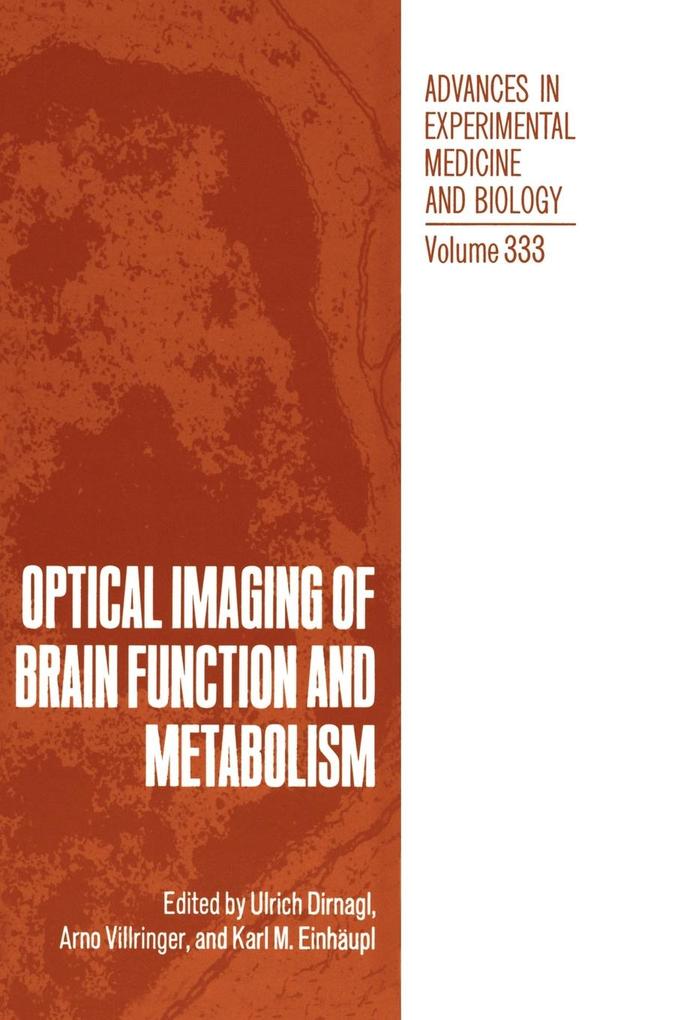
Zustellung: Mo, 04.08. - Fr, 08.08.
Versand in 2 Wochen
VersandkostenfreiBestellen & in Filiale abholen:
- . . . . At last the doctor will be freed from the tedious interpretation of screens and photographs. Instead, he will examine and scan through his patient directly. Wearing optical-shutter spectacles and aiming a pulsed laser torch, he will be able to peer at the beating heart, study the movement of a joint or the flexing of a muscle, press on suspect areas to see how the organs beneath respond, check that pills have been correctly swallowed or that an implant is savely in place, and so on. A patient wearing white cotton or nylon clothes that scatter but hardly absorb light, may not even have to undress . . . . -. David Jones, Nature (1990) 348:290 Optical imaging of the brain is a rapidly growing field of heterogenous techniques that has attracted considerable interest recently due to a number of theoretical advantages in comparison with other brain imaging modalities: it uses non ionizing radiation, offers high spatial and temporal resolution, and supplies new types of metabolic and functional information. From a practical standpoint it is important that bedside examinations seem feasible and that the implementations will be considerably less expensive compared with competing techniques. In October 1991, a symposium was held at the Eibsee near Garmisch, Germany to bring together the leading scientists in this new field.
Inhaltsverzeichnis
Near Infrared Spectroscopy of the Brain. - NMR and time-resolved optical studies of brain imaging. - Wavelength dependence of the differential pathlength factor and the log slope in time-resolved tissue spectroscopy. - Towards human brain near infrared imaging: Time resolved and unresolved spectroscopy during hypoxic hypoxia. - Measurement of human hypothermic cerebral oxygen metabolism by transmission spectroscopy. - Optical CT imaging of hemoglobin oxygen-saturation using dual-wavelength time gate technique. - Optical properties of normal human intracranial tissues in the spectral range of 400 to 2500 nm. - Imaging of Brain Function Using Intrinsic Signals. - Optical imaging of the functional architecture in cat visual cortex: The layout of direction and orientation domains. - Mapping of neural activity patterns using intrinsic optical signals: From isolated brain preparations to the intact human brain. - Fiber optic imaging of subcortical neural tissue in freely behaving animals. - Olfactory information processing in insects revealed by real-time optical imaging of intrinsic signals. - Thermal Imaging of the Brain. - Infrared imaging of brain function. - IR thermal imaging of a monkey s head: Local temperature changes in response to somatosensory stimulation. - Optical Measurement of Ion Concentrations in Brain Cells and Tissues. - Spatiotemporal inhomogeneity of [Ca]i in neurons. - Intracellular ion concentrations in the brain: approaches towards in situ confocal imaging. - Optical Access to the Brain Microcirculation. - Optical access to the brain: how artificial are cranial window techniques? . - Multiparametric imaging of microregional circulation over the brain cortex by videoreflectometry. - Towards imaging of cerebral blood flow and metabolism on a microscopical scale in vivo. -Emerging Optical Techniques. - Detection of brain free oxygen radical generated photons in vivo: Preliminary results. - Diffusion properties of brain tissue measured with electrode methods and prospects for optical analysis. - Measuring oxygen using oxygen dependent quenching of phosphorescence: A status report. - Laser fluorescence spectroscopic experiments for monitoring molecules in brain. - Infrared-interference videomicroscopy of living brain slices. - Non-Optical Reference Techniques. - Blood-brain barrier transport measurements using PET-scanning and intravenous double indicator technique. - Nuclear magnetic resonance studies of human brain in vivo: Anatomy, function, and metabolism. - Autoradiographic and biochemical imaging in cerebral ischemia. - Contributors.
Produktdetails
Erscheinungsdatum
31. Juli 1993
Sprache
englisch
Auflage
1993 edition
Seitenanzahl
296
Reihe
Advances in Experimental Medicine and Biology
Herausgegeben von
Ulrich Dirnagl, K.M. Einhäupl, Arno Villringer
Verlag/Hersteller
Produktart
gebunden
Abbildungen
XI, 296 p.
Gewicht
757 g
Größe (L/B/H)
254/178/19 mm
ISBN
9780306445286
Entdecken Sie mehr
Bewertungen
0 Bewertungen
Es wurden noch keine Bewertungen abgegeben. Schreiben Sie die erste Bewertung zu "Optical Imaging of Brain Function and Metabolism" und helfen Sie damit anderen bei der Kaufentscheidung.










